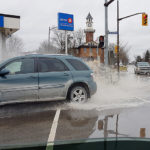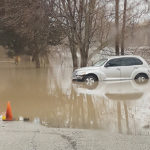
While the state of emergency was to stay in effect in Chatham-Kent this week, the flood waters of the Thames River slowly receded Sunday and Monday, leaving behind trees, silt and debris in its wake.
Under sunny skies and mild temperatures Monday afternoon, provincial municipal affairs minister Bill Mauro toured the flooded areas in Thamesville and Chatham, and let municipal officials know about next steps for disaster relief.
Mauro addressed first responders at the Chatham fire hall in the municipal building, thanking them for their excellent response and helping ensure there were no injuries or fatalities as a result of flooding along the Thames.
“Helping individuals and communities recover following a natural disaster is a priority for our government,” Mauro said in a statement. “Ontario offers assistance when a natural disaster damages municipal infrastructure or leads to extraordinary emergency response costs.”
He said the province will also assist with damage to eligible private property.
Once the Provincial Disaster Assessment Team finishes its evaluation in this area this week, the municipality and residents with flood damage will know if they are eligible for provincial assistance from two individual programs:
The Municipal Disaster Recovery Assistance (MDRA) program helps municipalities that have sustained emergency response costs, or damage to essential property or infrastructure, as a result of a natural disaster.
The Disaster Recovery Assistance for Ontarians (DRAO) program provides financial assistance to individuals, small businesses, farmers and not-for-profit organizations that have experienced damage to or loss of essential property as a result of a natural disaster. It is not a substitute for insurance.
Detailed information about Ontario’s disaster recovery assistance programs is available on the ministry website at ontario.ca/disasterassistance. Mauro said for residents to make sure they keep accurate records and receipts of damage in the event they can apply for the DRAO program.
Mauro said there has been an increase in natural disasters, much of it overland flooding, in past five years, and a discussion on how better to mitigate the problem with infrastructure programs needs to be had with the federal government. He said more forward-thinking, co-ordinated responses are needed to help stop flooding in the future, and stressed the need for disaster relief.
According to the Ministry of Municipal Affairs, the government has responded by providing assistance and by updating its disaster recovery assistance programs to better meet the needs of residents and municipalities. In 2017, Ontario set aside up to $12.5 million to provide disaster assistance across 37 municipalities that were affected by flooding.
Mayor Randy Hope, who walked with the minister along the Thames River near city hall, said he is very proud of the response of not just first responders like the police and firefighters who rescued people from their flooded homes, but also municipal agencies like the Public Utilities Commission, Entegrus and Union Gas, who co-ordinated quick action to ensure the safety of people.
“All the responders came together. Everyone was working as a team to make sure the community was protected. It was great to see such co-ordination and collaboration from everyone – from those who work for the municipality, and CHAPS and others,” Hope said. “There were no injuries and no fatalities and that’s something we are proud of. We were able to weather the storm and were very fortunate. We were lucky. Relative to water height, it was only 20 cm lower than the flood of ’85 and thankfully there was no ice on the river, which would have made it worse.”
Hope said once waters subside to normal levels, staff will be doing an assessment to check embankments, dykes, downtown Chatham, etc. to see what has been damaged and the debris left behind such as the downed trees on the banks of the river between the Third and Fifth Street bridges.
“From the residents side, we will start to phase in the recovery side. The state of emergency will stay in effect for the recovery for residents and the municipality to assess all the damage,” Hope said. “I want to make sure our community doesn’t look like a disaster area, so once the water subsides, we will deal with reconstruction and clean up.”
Tributary drains will also be checked and Hope said pumps were still working at maximum capacity as of Monday afternoon to make sure all the water drains. More information will be available to residents as the municipality gets it.




























